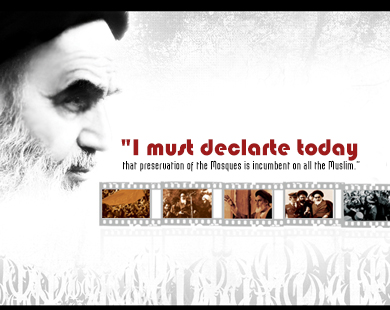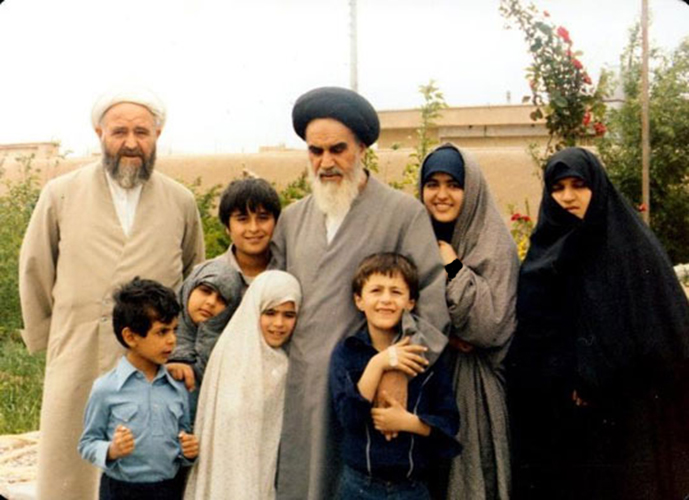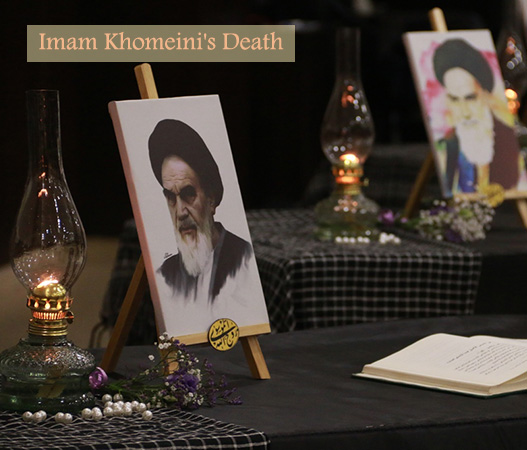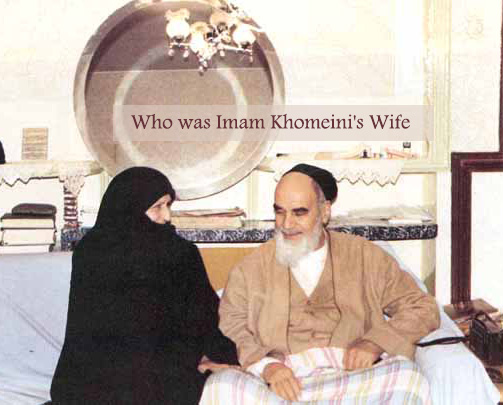Allah (SWT) has determined a path (i.e. a system of religious laws) to every prophet’s people (umma). Such a path is known as Sharia (a divine law to each umma). If the umma acted according to its own divine law, the result would be that this umma would reach the high spiritual level of its prophet. Allah’s divine law is not a collection of separate or scattered codes; instead, it has a unique spirit or method which brings its codes together in a brilliant and highly harmonized sequence. This spirit which unites the creeds of the divine law is the method. So, the divine law without this method is just like a body without a soul in his unitary being, and in order for man to be an inclusive locus of manifestation of the Names and Attributes of Allah. Without knowing the spirit (or method), the sharia would turn out to be a mere collection of scattered codes distinct from one another.
When Imam Khomeini said that the government is the practical philosophy of the divine law (feqh) in all its dimensions, he was referring to one level of the monotheistic dimensions within the sharia which appears as a number of multiple creeds, whereas in fact it has only one spirit.
Today when the issue of culture becomes a subject for discussion and analysis among those who are interested in propagating Islam and distributing its great knowledge – those who studied the accumulated scientific efforts of the great Muslim leaders and scholars all along centuries – they face a problem in their endeavours to propagate the great instructions and knowledge of Islam. And here comes the question: does the main problem lie in the insufficiency or lack of different resources; i.e. books, research papers, etc.? It should be clear that the responsibility of distributing the great Islamic knowledge is shouldered by the students and scholars of Islamic sciences. Here another question is raised: why do we only find a very few number among those students and scholars who can clearly assimilate the Islamic issues and matters concerning life and its contemporary challenges? Where is the inclusive character that can intermingle the power of the intellect with the great dimensions of the deep Islamic spirituality in order to produce a unique political and social awareness and bring about liveliness and vivacity into the society?
It is not then a problem of knowledge and information; rather, it is a question of possessing a spirit (method) connecting all the Islamic knowledge in one texture which can elevate the students towards completeness and reach a rank or level that has been a fact in the time of Imam Khomeini. Let us go a step backward and have a look on what causes the multiplicity of religious methods and divine laws, each of which belongs to a certain umma, and in effect, to a certain prophet. What is the secret behind such a distinction and multiplicity between prophets’ various Sharias (divine laws)? Is it due only to the circumstances and changing conditions of time which vary from time to time? Or is it due to the different natures of peoples to whom prophets, and of course the divine laws, were sent? Or is it something else?
But before answering these questions, it is important to notice that the differences between various divine laws are not huge ones. As a matter of fact, they are limited. Furthermore, we may not be able to find any relation between what is different (between the divine laws) and temporal changes. That is to say, if we found a difference between one divine law and another divine law, we may not be able to relate it to the difference between the time of one people and the time of another people. We may not even be able to relate it to the social or psychological or cultural level of different peoples.
Therefore, some commentators have denied any differences or distinctions between prophets’ divine laws for many reasons. One of these reasons is that the difference in temporal conditions and terms was not something to be noticed in the ancient times; that is, it was not a fundamental difference. Another reason is that the Sharia, basically, is not formed on the basis of the accidental and changing natures of people; rather, it is formed according to the fixed human innate natural disposition (al-fetra).
The truth is that the distinction between various divine laws (Sharias) is, basically and above all, due to the distinction between the messengers of these laws. The Sharia, according to what Muslim Sufis (Urafa) say, comes to light or is revealed via a special intuitive or mystical knowledge bestowed on each prophet by Allah (SWT). And as long as the prophets themselves are not equal in terms of the depth of knowledge and their divine ranks, the Sharias, which are manifested through their intuitive knowledge, are not equal in much the same way. But what does this mean? Let us put it more clearly. Messengers of Allah are all great and grand people, they all have perfection and known as sincere and loyal servants of Allah. However, they have what we may call it vertical distinction rather than horizontal distinction; that is, they are not distinct in their essential natures or their goals or missions, on the contrary, they have the same mission, the same goals, the same path and method. What draws the distinction then is the depth of their knowledge according to how far each prophet is near to Allah. The case here resembles a number of circles, with each circle enveloped or contained by a bigger circle. In this case we cannot say that the circles are different or horizontally distinct; rather, we say that the circles are vertically distinct; i.e. the bigger circle has all what is found in the small circle plus more extra things. In logical terms, the relation here between the circles is absolute generality and peculiarity. In much the same way, prophets are vertically distinct, since they are ranked according to the depth of knowledge they could acquire and the nearness to Allah which they attained. In the wholly Quran we read this verse:
(These are the apostles, some of whom We gave an advantage (superiority) over others: of them are those to whom Allah spoke, and some of them He raised in rank …)
(Surat Al- Baqarah, 253)
This is the fundamental and essential distinction which can be seen in the case of the messengers of Allah. Accordingly, those who noticed the sharias on horizontal grounds, could not discover the distinction between these sharias. And their mistake was that they did not notice the vertical distinction which outstands each sharia from the other.
In other words, the sharia has an end which is measured according to the divine Gnostic postions or ranks of the prophets. And since these divine positions are distinct gradually in an ascending fashion, and since there is superiority – as such – between the prophets, such superiority is, therefore, similarly noticed in the sharias revealed by them.
In more plain words, Allah’s law (Sharia) is one and the same, and according to Him there is no such multiplicity and variety of laws. This Sharia descends in a sequence of vertical stations, with each station representing (standing for) a real spiritual (mystical) rank. Now, the degree of each prophet’s superiority (which is due to his nearness to Allah) is what allows him to reveal more or less stations of the one and unique Sharia of Allah. This one and unique Sharia is valid for every time, for every society and for every man. It is known as the Seal of sharias (asharia al-khatamah) or the eternal Sharia. The only apostle who has been honoured to reveal the highest and top rank of it was the grand apostle of Islam Muhammad (Allah’s blessings and peace be upon him and his pure immaculate family). Each of the other grand apostles has revealed a certain rank according to the rank of his own intuitive revelation.
Thus, the multiplicity or variety of the divine laws (Sharias) is basically due to the difference in method. The Sharia was taking a new state or method in every phase until it reached the grand apostle Muhammad (SAW) when he revealed it completely, and thus it has become valid and lasting till the end of days.
The question then is not within the framework of the knowledge or information that we have. The essence of the problem does not rotate around answering the crucial and fateful questions in the human life. Rather, the question lies in knowing the method which brings together all the knowledge in one texture which weaves all the various knowledge in one dress the wearing of which allows our Muslim umma to walk steadily in its integral travel towards the divine targets.
Here we can observe the most important dimension in the great character of Imam Khomeini. This grand person attached himself to the spirit of the divine law (Sharia) which streamed into his life and movement in such a way that led him to wake up the umma.
The great apostle Muhammad (SAW) was unique among all the other apostles:
(those who follow the apostle, the uninstructed prophet, whose mention they find written with them in the Torah and the Evangel, who bids them to do what is right and forbids them from what is wrong, makes lawful to them all the good things and relieves them of their burdens and the shackles that were upon them …)
(Surat Al-A‘RAF, 157)
Imam Khomeini, in much the same way, was unique among all the scholars and men of religious knowledge. He rushed to relieve us of the burden of straying and of the suffering of losing the target and being without a method. In doing so, he freed us from remaining in the circle of confusion and delusion, a circle which we never imagined we could get out of in the time of the long occultation of Imam Mahdi (may Allah hasten his reappearance). Imam Khomeini was leading the ship of salvation to a pre-determined destination, i.e. to Imam Mahdi (A S). The consequence of Imam Khomeini’s movement was a sudden and violent wake of the umma, after a long sleep, to restore its position and to take the right path and reach the right destination. In more than one occasion, Imam Khomeini repeated that the Islamic Revolution would remain alive until the appearance of Imam Mahdi (A S). The best description for what Imam Khomeini has done to the umma is what our grand leader of the Islamic Revolution today, Imam Khamenei, said after the departure of Imam Khomeini: we were sick and Imam came to cure us; we were brass and Imam came to turn us into gold; we were dead and Imam came to send us back to life; he is, indeed, Rohu Allah (Imam’s first name which means ‘the Soul of Allah’).
The thought of Imam Khomeini presents a full and comprehensive method which includes the Islamic ideological theory in its authentic reality. It is the method which is so close to real Islam to the extent that any other method would look fake or weak compared with Imam’s method. We can say that Imam is the best explainer of the authentic Islam of Muhammad (SAW) all along the period of Imam Mahdi’s long occultation. Imam Khomeini, from the beginning of his movement, explained both theoretical and practical knowledge and decrees of Islam, orienting people to its goals and ends. He defended the instructions and principles of Islam, and confronted all the alterations and doubts about it. He has not left anything essential and necessary to his followers without explanation in a simple, easy and understandable fashion. In effect, his thought and method were a beacon to his followers and a guide star to those who believed in his method.
His thought is the one each part of which explains the other in a brilliant harmony and a beautiful sequence. His thought draws a uniquely consistent picture with dimensions that encompass all the questions and challenges of life. Imam wrote and spoke of the various ethical, theological, mystical, social, political, legal (canonical), philosophical and cultural dimensions of Islam. His speech was compassionately directed to all the classes, ranks and groups of people. His words and calls were always preceded by and synchronized with deeds, a fact that gave him credibility and allowed him to win people’s trust to the greatest extent. Therefore, his calls and demands were, and still are, influential.
In the light of the above mentioned items, we realize the repeated declaration of the great leader of Islamic Revolution Imam Khamenei, “our path is the same path of Imam Khomeini, our targets are Imam’s targets, our lessons are Imam’s directions; for he was always – and will always be - our instructor. We do not have targets and aspirations more sacred, more suitable and superior than the targets and aspirations of Imam.”
We need to do a lot of work to propagate Imam Khomeini’s thought, to adopt and defend it. When Imam Ali (S) says “for everything you do, you need to have a knowledge of it”, so how can our deeds and moves be achieved at strategic levels? And if knowledge and culture represent the spirit and roots of any movement, what then are the roots of our movements? Is it just enough to have a spiritual and scientific attachment? Or does it need – if we seek to intensify our movement – to have a cultural and intellectual attachment as well? Any revolution, when it gets underway in its early years, it goes off due to the spirit that rejects injustice and suppression practiced in the times before it. Such a revolution would soon confront a large number of obstacles which cannot be overcome in case it did not precisely determine its method and encompassing views concerning all the questions and issues.
Hence, our search for the method of Imam Khomeini is not a search for the starting point, for it is obvious. Rather, it is a search for the roots, the foundations, the vision, and the complete method. It is a search for the practical sources and origins of the revolutionists’ movement when they become in charge and requested to give solutions to the needs of society and umma in critical times.
The main question then is: how do we get to know the method of Imam Khomeini? This question leads to a number of other questions. What are the basic principles out of which Imam went off in his general course in life? What are the foundations which formed his revolutionary movement? What are the main ideas which, if brought together, would display Imam’s method clearly and entirely? How can we find these principles and ideas? And who is the proper person who has the ability to draw a consistent picture of all the dimensions without missing or excluding the scale of priorities?
The problem here is not the shortage of texts; on the contrary, we have a large number of Imam’s texts tackling many issues. We have a lot of his words and texts in different and various occasions in which he gave clear directions and key answers to basic challenges and problems. Such words can even be turned into slogans for any time and make a general base to build upon. But the problem is that, in most of the cases, we are not aware of the location of these texts and thoughts within the whole system. And this may have led to the loss of priorities and a clear weakness in determining targets.
Here lies the importance of the method, or the line of thought.
Imam’s line is not merely a number of speeches or manifestos said in several occasions and tackled all the important and essential issues of the Muslim umma. Rather, Imam’s line is the awareness or consciousness which can explain several phenomena and give solutions to all the problems in a fixed and steady manner without showing any contradictions.
Therefore, the search for Imam’s line of thought must find its starting point in his sincere and loyal followers; in those in which Imam’s hopes and aspirations have been fulfilled; in those who undertake the holy jihad; in those who eagerly follow Islam because of Imam; and, above all, in the present Imam and leader of the Islamic Revolution who has undertaken the greatest responsibility.
The divine rules or standards in organizing the universe and in upbringing societies show that “the way we are, the way our rulers and governors will be”. The Iranian people has shown loyalty to Imam Khomeini and demonstrated to the whole world that it is one of the best peoples all along the history of mankind in terms of obeying and following the leading Imam. The great sacrifices which have been given by this great people are above our imagination. The assignment of Imam khamenei as the present leader of the Islamic Revolution was a sign of Allah’s mercy and a gift to this people that deserves a lot. It is a proof that the spirit of Imam Khomeini is still alive, and still sends life and energy to the minds and hearts of all the sincere revolutionists both in Iran and all over the world. Imam Khomeini’s spirit is still, and will remain, a tornado which will eradicate many of the corrupted and tyrannical regimes in this world.
Those who cannot understand Allah’s rules and standards in guiding societies would have expected, after the death of Imam Khomeini, a naïve and gullible person to undertake the holy position of authority (guardianship) which is backed by Imam Mahdi ( may Allah hasten his reappearance). As a surprise to many, and a shock to the majority, the person who came after Imam Khomeini is an extension of the revolutionist spirit of Imam Khomeini; a volcanic fire in facing the tyrants and bloody murderers who rule our world today. He is the spirit of Khomeini which is still guiding us and providing us with life and energy. Therefore, he is the best to explain Imam Khomeini’s method.
* Sayyid Muhammad Moussa



















